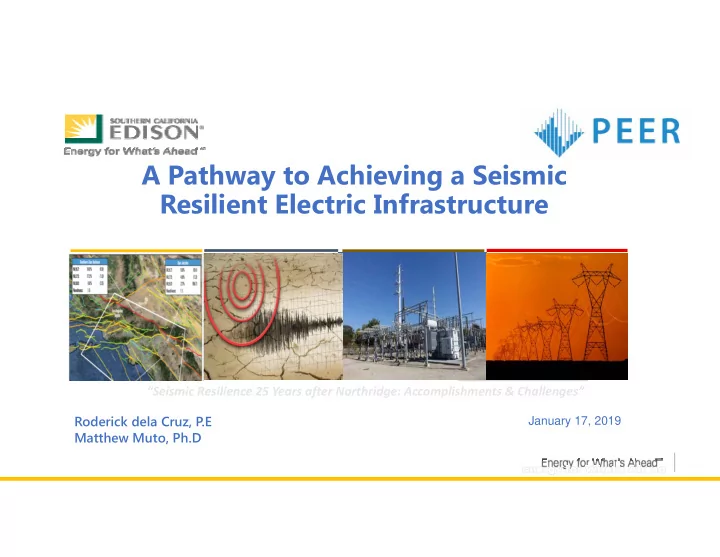

A Pathway to Achieving a Seismic Resilient Electric Infrastructure “Seismic Resilience 25 Years after Northridge: Accomplishments & Challenges” Roderick dela Cruz, P .E January 17, 2019 Matthew Muto, Ph.D
Southern California Edison owns and operates a transmission and distribution grid that delivers electricity to five million customers in a 50,000 square ‐ mile area of central, coastal and Southern Committed to Safe, Reliable, Affordable and Clean Power California. 15 million Californians count Serving 5.0 million customers in Southern California on us for electricity 24 hours a day, seven days a week. 13,000 Miles of 13,000 Miles of 90,000 miles of 90,000 miles of Over 800 Over 800 Over 80+ Over 80+ Located in Seismically Active Regions Located in Seismically Active Regions Electric Electric Electric Distribution Electric Distribution Substations Substations Dams Dams in the U.S in the U.S Transmission Lines Transmission Lines Lines Lines
Electric Seismic Resiliency Program • To ensure that SCE-Electric Power Infrastructure System reach a level of resiliency where risk is as low as reasonably practicable. Reduced failure probabilities… " ability to anticipate, prepare for, respond and adapt to Reduced consequences from failures… incremental change and sudden disruptions in order Reduced time to recovery… to continue to provide services.“
Seismic Resilience Program: Infrastructure Work streams SCE Service SCE Service Territory Territory Building & Facilities Electric Infrastructure Generation Infrastructure IT/Telcomm Dams, Hydro facilities Antenna towers Administrative and Distribution systems • • • • operational buildings Peakers Telecommunications sites Transmission system • • • Powerhouses IT data centers Warehouses Transmissions, • • • • Garages Mountainview distribution and substations • • Generating Station 4
Path to Achieving a Seismic Resilient Electric Infrastructure Mitigation Hazard or Threat Reduce Risk Planning Response Respond to Planning Risks Damage Prioritized on the ground damage Assessment assessment Tool Predictive Common Real Time Operating Picture 5
Achieving Seismic Resiliency of Electric Infrastructure Control Building Distribution Systems Transmission Corporate Business Substation Assessment & Assessment and Assessments and Resiliency Program Seismic Assessments Mitigation Mitigation Mitigation and Mitigation 6
Seismic Assessments & Mitigation: Substations DAMAGES FUNCTIONALITY FRAGILITIES Seismic Assessment COST HAZARDS 12
Seismic Assessments & Mitigation: Transmission Towers Site Verification Surface Faulting Towers are more vulnerable than poles in terms of Bucket Auger Drilling for PGDs. Downhole Logging for Landslide Evaluation Landslides Mountainous terrain and saturated soil conditions generate larger PGDs and are more susceptible to landslides. Liquefaction Areas near lakes, Mitigation ‐ Soil Nailing waterfronts, and stream channels are more susceptible to liquefaction. Structure Color Code Scores Based on Vulnerability Analysis
Seismic Assessments & Mitigation: MEER and Control Bldg How’s is the building going to What are potential perform during deficiencies? earthquake Performed Screening Level Assessments ‐ Occupied Buildings Determined estimated performance levels and developed prioritization for further assessments Perform ASCE 41 Tier Assessments of Selected Control Buildings Need Retrofit? Seismic Assessment ‐ Engineering and Seismic Mitigation Buildings 9
Seismic Resilience: Standards, Testing and Qualifications HANGING EQUIPMENT SHAKE TABLE TEST RELAY RACK SHAKE TABLE TEST TRANSFORMER QUALIFICATION ANALYSIS • Seismic design recommendations for substations, including qualification of each equipment type. • Design recommendations consist of seismic criteria, qualification methods and levels, structural capacities, performance requirements for equipment operation, installation methods, and documentation. 11
Seismic Resilience through Benchmarking & Collaboration • Risk Management • Shake Table Testing • Research & Development • Standards update & Improvements • Emergency Management • Post ‐ Earthquake reconnaissance survey 12
Seismic Resilience through Emergency Management • Develop tools to enhance situational awareness capability and effective emergency response. • Collaboration among business units and internal/external stakeholders on emergency drills/exercises, vulnerability assessments and emergency management plan development. 13
Seismic Resilience: Generation Infrastructure • SCE Generation manages 2,459 MW of generating capacity • 33 Hydropower Plants • 6 Natural Gas Plants • 1 Diesel Plant • High Hazard Dams are periodically assessed for safety under seismic loading, as required by law • Assessment of the seismic resilience of generating plants in progress to identify and prioritize potential improvements to seismic resilience 14
Seismic Resilience: Generation Infrastructure High Hazard Dam Assessments • SCE owns 83 dams, 28 of which are designated as high hazard by state and/or federal regulators • Current regulations require deterministic analysis, with some adjustment of ground motions based on fault activity (slip rate) • Models range from 2-D linear to 3-D nonlinear • Validation of models using field data enhances confidence in results • Focus on prevention of life-threatening Uncontrolled Rapid Release of Water 15
Seismic Resilience: Generation Infrastructure Generating Plant Assessments Generating Plant Assessments • Identify potential vulnerabilities • Structural (building, enclosure, etc.) • Equipment (turbines, transformers, etc.) • Geologic (liquefaction, rockfall, etc.) • Gather relevant information • Drawings, equipment lists, design documents, operating procedures • Facility walk-downs and operator interviews • Facilitated risk assessment workshop for geologic hazards • Analysis focused on ability of plant to rapidly resume operations following earthquake • Fragilities developed for each element • Logic model developed for plant operation • Fragilities and logic model are combined to obtain a plant fragility function 16
Seismic Resilience: Generation Infrastructure Seismic Mitigation Seismic Mitigation • High Hazard Dams • If deficiencies are identified, potential risk reduction measures include retrofit, reservoir restrictions, and enhanced preparedness (e.g. surveillance cameras, warning sirens, community outreach • Recent recognition that smaller earthquakes do not pose safety risk, but could potentially impact operations. Current practice is to flag potential vulnerabilities for post-earthquake inspections • Generating Plants • Identify “quick wins” - mitigations with low-cost, fast implementation, and consistent with good practice (e.g. addressing unanchored equipment, securing control room monitors) • Evaluate costs and benefits of larger-scale mitigations (e.g. structural retrofits) and prioritize appropriately • Need to better understand resiliency of dependent systems, such as the electric and gas delivery systems 17
Together… we can build a resilient Electric Power System Infrastructure! 18
Recommend
More recommend